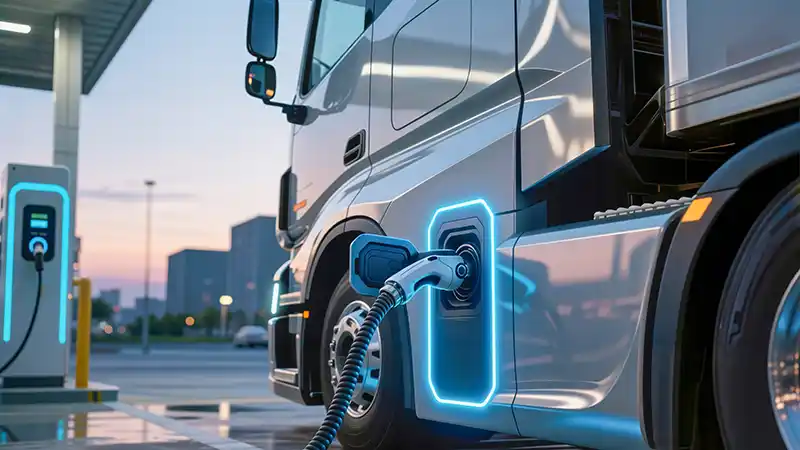The trucking industry is the backbone of commerce, ensuring goods are transported efficiently across the country. However, one of the biggest challenges for fleet owners and operators is managing the maintenance of their vehicles. Unplanned breakdowns can lead to costly repairs, lost time, and dissatisfied customers. This is where predictive maintenance comes into play—a game-changing approach that leverages technology to anticipate maintenance needs before they become critical issues.
In this blog, we’ll dive deep into what predictive maintenance is, how it works in the trucking industry, its key benefits, the tools and software available, and what the future holds for this innovative maintenance strategy.
What is Predictive Maintenance?
Predictive maintenance is a proactive approach to vehicle upkeep that uses data-driven insights to predict when a truck component is likely to fail. Unlike traditional maintenance methods—such as reactive maintenance (fixing something after it breaks) or preventative maintenance (servicing vehicles at regular intervals)—predictive maintenance focuses on real-time monitoring and advanced analytics to anticipate issues before they occur.
In essence, predictive maintenance shifts the focus from reacting to problems to preventing them entirely. By leveraging technology such as IoT (Internet of Things) sensors, telematics systems, and machine learning algorithms, this approach ensures that trucks are maintained only when necessary, reducing costs and avoiding unnecessary repairs.
For example, rather than replacing tires based on mileage alone, predictive maintenance systems can analyze wear patterns, pressure, and temperature to recommend replacements only when needed. This not only saves money but also ensures optimal safety on the road.
How Predictive Maintenance Works in the Trucking Industry
In the trucking industry, predictive maintenance relies on a combination of technology, data collection, and analytics. Here’s a breakdown of how it works:
1. Data Collection
Sensors installed on trucks continuously monitor various components, such as the engine, brakes, tires, and transmission. These sensors collect data on performance indicators like temperature, pressure, vibrations, and wear. The data is then transmitted to a centralized system for processing.
2. Data Analysis
Once the data is collected, it is analyzed using advanced algorithms and machine learning models. These tools identify patterns, anomalies, and trends that could indicate potential issues. For example, an unusual vibration in the engine could signal an impending failure.
3. Alerts and Recommendations
When the system detects an issue, it sends an alert to the fleet manager or driver. The alert includes detailed recommendations for corrective actions, such as replacing a part or scheduling a repair.
4. Action
Repairs or maintenance are performed during planned downtime, minimizing disruptions to operations. This ensures that trucks spend more time on the road and less time in the shop.
Predictive maintenance is a dynamic process that evolves as more data is collected. Over time, the system becomes more accurate and efficient, further enhancing its value to fleet owners.
Benefits of Predictive Maintenance
The advantages of predictive maintenance extend far beyond simply avoiding breakdowns. Here are the key benefits it offers to trucking businesses:
1. Cost Savings
One of the most significant benefits of predictive maintenance is the potential for cost savings. By addressing issues before they escalate into major problems, fleet owners can avoid expensive repairs and component replacements. Predictive maintenance also reduces the need for unnecessary preventative maintenance, ensuring that resources are used efficiently.
For example, predictive maintenance can identify when a truck’s engine is operating outside of its optimal range. Addressing the issue early could prevent a costly engine replacement down the line.
2. Downtime Reduction
Unplanned downtime is a nightmare for trucking businesses. Every hour a truck is off the road translates to lost revenue and delayed deliveries. Predictive maintenance minimizes downtime by scheduling repairs during off-peak hours or when the truck is already idle.
For fleet owners, this means fewer disruptions to operations and more consistent service for customers.
3. Improved Safety
Predictive maintenance enhances safety by identifying potential issues before they lead to accidents. For instance, sensors can detect when brake pads are wearing thin or when tire pressure is too low, allowing for timely repairs that prevent dangerous situations on the road.
4. Extended Vehicle Lifespan
Regular maintenance is essential for prolonging the life of a vehicle. Predictive maintenance ensures that trucks are always in optimal condition, reducing wear and tear on components and extending the overall lifespan of the fleet.
5. Better Customer Satisfaction
Reliable deliveries are the cornerstone of customer satisfaction. By preventing breakdowns and delays, predictive maintenance helps trucking businesses meet delivery deadlines and maintain strong relationships with their clients.
6. Environmental Benefits
Predictive maintenance contributes to sustainability by reducing fuel consumption and minimizing waste. Well-maintained vehicles operate more efficiently, producing fewer emissions and reducing the environmental impact of trucking operations.
Tools and Software for Predictive Maintenance
Implementing predictive maintenance requires the right tools and software. Here are some of the most popular options available in the trucking industry:
1. Telematics Systems
Telematics systems are at the heart of predictive maintenance. These systems collect real-time data on vehicle performance and transmit it to a central platform for analysis. Leading telematics providers offer features such as GPS tracking, fuel monitoring, and diagnostic alerts.
2. Fleet Management Software
Fleet management software integrates predictive maintenance capabilities with other fleet management functions, such as route planning and driver tracking. Platforms like TruckBuddy (coming soon) will allow trucking businesses to log and monitor maintenance records, ensuring that vehicles stay in top condition.
3. IoT Sensors
Internet of Things (IoT) sensors are essential for collecting data on vehicle components. These sensors monitor everything from tire pressure to engine temperature, providing the insights needed for predictive maintenance.
4. Machine Learning Algorithms
Predictive maintenance relies on advanced machine learning algorithms to analyze data and identify patterns. These algorithms can predict component failures with a high degree of accuracy, enabling fleet managers to take proactive measures.
5. Mobile Apps
Mobile apps make it easy for drivers and fleet managers to access maintenance alerts and recommendations on the go. Apps like TruckBuddy will provide a centralized platform for managing maintenance tasks, tracking subscriptions, and accessing learning resources.
The Future of Maintenance in Trucking
As technology continues to evolve, predictive maintenance is expected to become even more advanced and widespread in the trucking industry. Here are some trends to watch for in the coming years:
1. Integration with Autonomous Vehicles
As autonomous trucks become a reality, predictive maintenance will play a critical role in ensuring their reliability and safety. Advanced sensors and AI systems will monitor autonomous vehicles in real time, addressing issues before they impact operations.
2. Enhanced Data Analytics
The volume of data generated by trucks is growing exponentially. Future predictive maintenance systems will leverage even more sophisticated analytics to provide deeper insights and more accurate predictions.
3. Increased Adoption by Small Fleets
While predictive maintenance has traditionally been more accessible to large fleets, advancements in technology are making it more affordable for small trucking businesses. This democratization of predictive maintenance will benefit the entire industry.
4. Sustainability Benefits
Predictive maintenance contributes to sustainability by reducing fuel consumption, minimizing waste, and extending the lifespan of vehicles. As the industry moves toward greener practices, predictive maintenance will play a key role in achieving environmental goals.
Embracing Predictive Maintenance
Predictive maintenance is more than just a trend—it’s a transformative approach that is reshaping the way trucking businesses manage their fleets. By leveraging data and technology, predictive maintenance offers unparalleled benefits, from cost savings and downtime reduction to improved safety and customer satisfaction.
For fleet owners and operators, adopting predictive maintenance is a smart investment in the future. As tools like TruckBuddy and IoT sensors become more accessible, implementing predictive maintenance will become easier and more effective than ever before.
The road ahead is full of opportunities, and predictive maintenance is the key to unlocking them. By staying ahead of the curve and embracing this innovative approach, trucking businesses can ensure their fleets remain reliable, efficient, and profitable for years to come.












